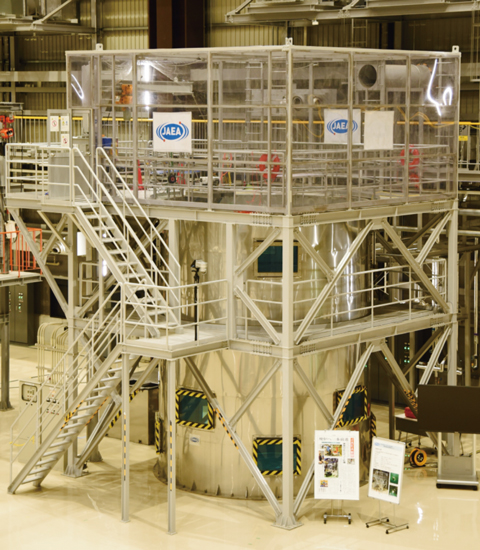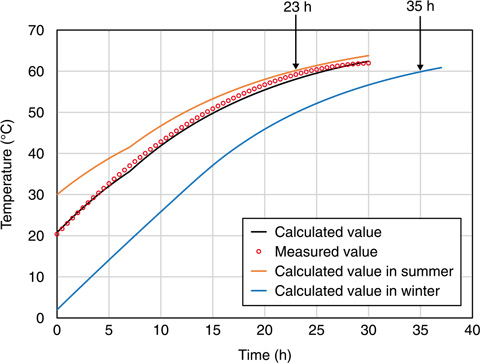
Fig.1-8 Robot test pool

Fig.1-9 Measured and calculated values when the temperature is increased from room temperature to 60 ℃
The Naraha Center for Remote Control Technology Development (NARREC) is a mockup facility to examine remote devices for the decommissioning of TEPCO’s Fukushima Daiichi NPS. NARREC provides various test equipment and has accepted many users since beginning full-scale operation in April 2016. The Robot Test Pool in NARREC is commonly used for testing underwater robots (Fig.1-8).
This pool is composed of cylindrical stainless steel (inner diameter: 4.5 m, water depth: 5 m) with an insulating polystyrene cover. The water temperature can be varied from room temperature to 60 ℃ by circulating warm water generated by a heater. As the pool contains 80 tons of water when full, it takes approximately 1 day to increase the water temperature from room temperature to 60 ℃ and approximately 10 days to decrease the water temperature from 60 ℃ to 20 ℃ via natural heat dissipation.
Thus, a schedule taking into account the water temperature adjustment time is needed for optimizing the planning and usage of the pool. This includes the clarification of reasonable water temperature adjustment time, taking into consideration the varying heat dissipation behavior of the outer wall, bottom, and water surface of the pool due to the temperature and humidity fluctuations between summer and winter. Therefore, the temperature behavior was investigated and used to develop a model that can be used to evaluate the heat dissipation behavior and resulting temperature change of the water based on the atmospheric conditions and pool structure.
A comparison of the measured and calculated values using the developed model in June when the pool was increased from 20 ℃ to 60 ℃ is shown in Fig.1-9, as are the calculated values for a similar increase under summer and winter conditions. At the measured value, the room temperature, water temperature, and humidity were 24.7 ℃, 20.8 ℃, and 50.0%, respectively. For the modeled summer conditions, the room temperature, water temperature, and humidity were assumed as 35.7 ℃, 30.0 ℃, and 80.0%, respectively. For the modeled winter conditions, the room temperature, water temperature, and humidity were assumed as 5.0 ℃, 2.0 ℃, and 20.0%, respectively. The results presented here confirm that the developed model satisfactorily reproduced the measured values. Additionally, it would take 23 and 35.5 hours for the water temperature to reach 60 ℃ in summer and winter, respectively. Further calculations demonstrated that keeping the pool covered can help maintain the water temperature by reducing heat dissipation, and that using the exhaust duct attached to the pool can halve the time required to cool down.
As the developed model allows for the evaluation of the seasonally dependent behavior of the water temperature, it is now possible to estimate the preparation period required for facility use.
(Ryoki Arakawa)